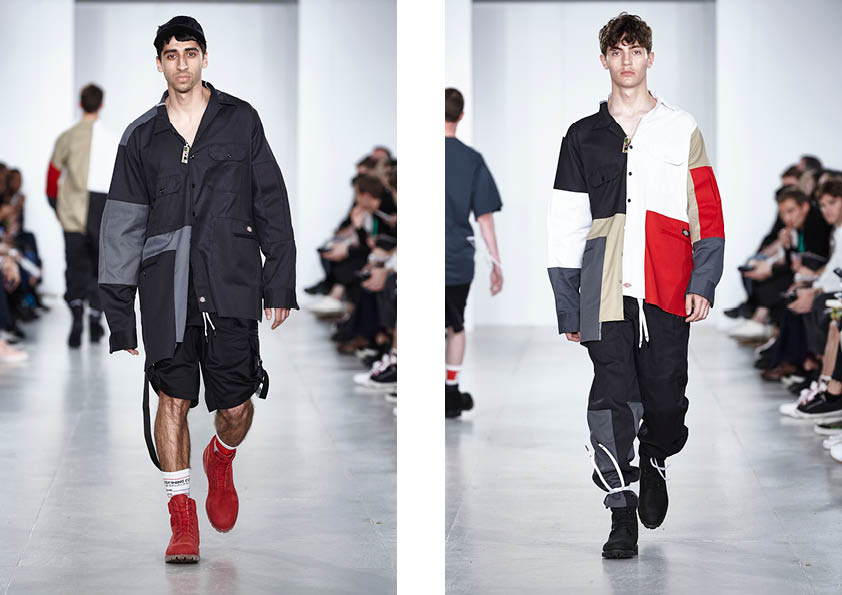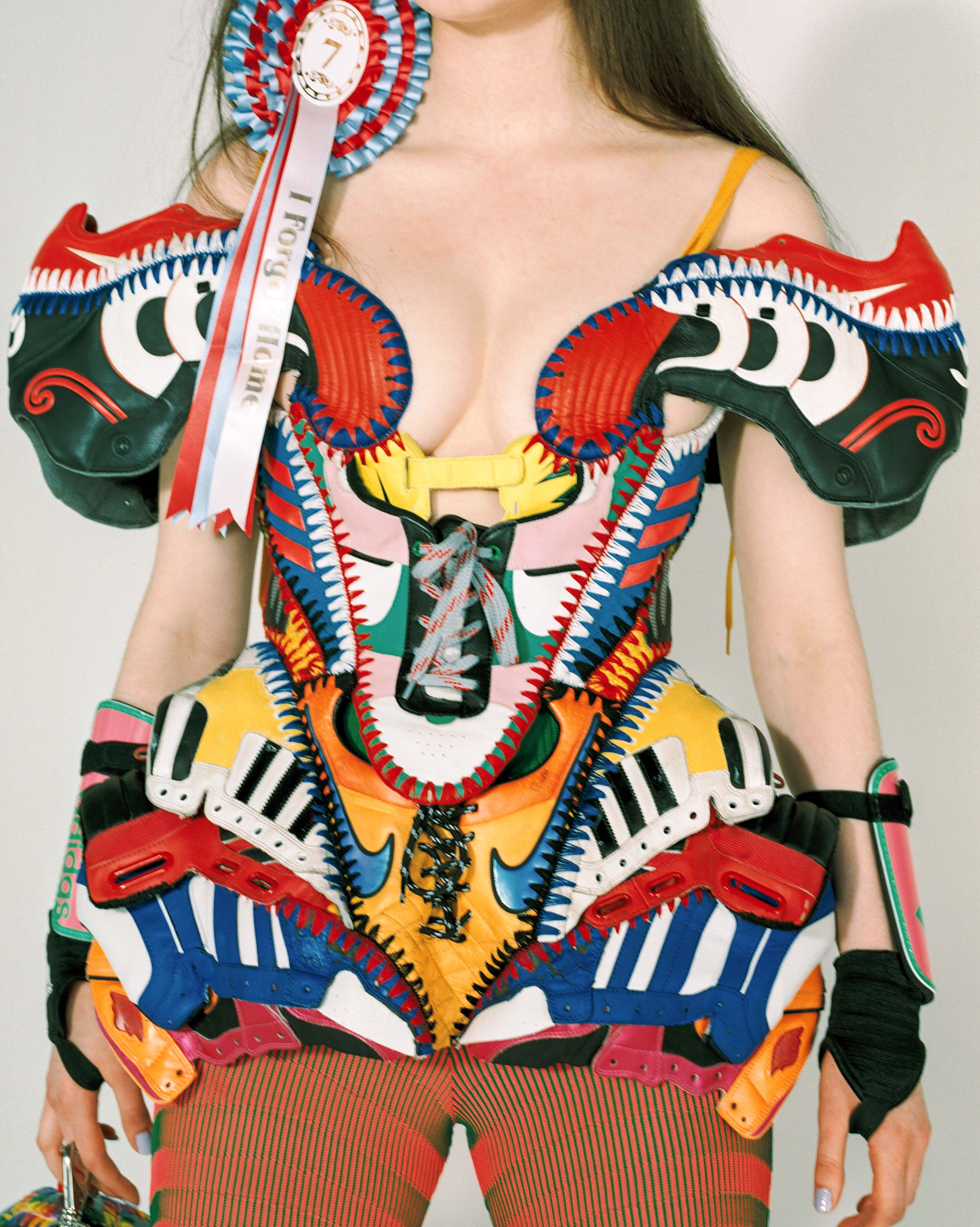In 2017 Liam Hodges created a cut and sew collection, as is fairly synonymous with the house, made out of a variety of upcycled garments. The one look that sticks in the mind is the use of Dickies workwear trousers repurposed for both tops and bottoms. Repurposing a staple of the youth culture wardrobe and a traditional trade garment onto the high fashion runway has a sort of irony about it as well as resourcefulness and playful mentality. Although there is no explicit reference towards sustainability within the rationale, innovations like this are important to changing the consumer mindset, they give a window into the world of high fashion for any price range via the ideas the pieces breed.
"Two years deep into wearing his product almost every day, designing clothing is for Liam now about more than making fashionable statements. Instead, tangible reality, designing pieces that deliver more and work harder for the customer’s hard-won resources are key. The move towards the demands of seasonless collections lends a sense of continuity. “Jackets are sold all year because somewhere on earth it’s probably cold, people want to buy shorts all year because they go on holiday all year.” To this end from Spring/Summer 2017 patchworking and workwear will join the “just more honest” street casting of models as consistent Liam Hodges motifs.
However, whatever your sense of reality and continuity, wearing an oversized padded bomber or a patchwork tracksuit are progressive acts that take confidence. This season is also “about play, aiding creativity” and messing about with shape, proportion and collaging. Themes Liam intends to develop from now on, and present throughout this collection including in the workwear shirts and 874 trousers Liam has worked on with Dickies, the 96-year-old Texan workwear heroes. To surmise then, going forward is about refining what really works and workwear in particular. There is a renewed focus on the quest to design product that intrinsically embodies the Liam Hodges brand and communicating this to the world." Words: Daryoush Haj-Najafi https://www.liamhodges.co.uk/collections/ss17/



The most refreshing name on the lips of the London fashion scene is the decidedly anti-high fashion Johnny Banger of Sports Banger. Johnny created sports banger with a range of t-shirts displaying appropriations of popular culture iconography and political comments with a firmly socialist and working-class backbone. An eye for DIY resourcefulness comes from his financial means as well as a dislike for the pretention of the industry. The most obvious statement of this comes via Johnnies Slazenger sock balaclava which really optimizes the ethics of the brand.
The 2018 collaboration with Slazenger sold exclusively in Sports Direct had a strong 'for the people' message and marked a move into mass production. This understandably attracted some criticism and did appear to be in small part a sell out of the brand's moral standpoint. However, on the Off London Fashion week red carpet in 2019 Johnny produced a typically Banger show that featured almost entirely upcycled leftover stock from the Slazenger collaboration including lilos, towels and plastic bags. This is a firm statement of resourcefulness and once again shows us the buyer that we can make do with what's available from past seasons by repurposing for the now.
"Having worked closely with Tottenham Textiles workshop and its young apprentices to create it, the collection itself was made up of repurposed pieces from his core collection, as well as reworked pieces from the recent Slazenger Banger collab that didn’t sell: “I had a load of leftover lilos from the Slazenger line, because who puts a lilo in their suitcase when they’re going on holiday? No one – so I made tracksuits and MA-1 bombers out of them. It only really all came together on Wednesday to be honest, it’s been mad. I didn’t realise how much work went into (shows).” Each of the vinyl pieces were designed in collaboration with London-based Romanian designer Ancuta Sarca, who Banger met when she came to one of his Mega Raves.
At a time when the UK’s future is so wildly uncertain and the creative industries are struggling as a consequence, and major fashion labels continue to mine the depths of youth culture for commercial gain, seeing such a diverse group of people come together to throw a DIY rave runway show with such wild energy and authenticity – particularly at a time when London nightlife is in such a state of emergency – made it clear that exciting things are still bubbling away under the surface. You just need to know where to look."
https://www.dazeddigital.com/fashion/article/43372/1/london-bootlegger-sportsbanger-acid-house-rave-fashion-show-tottenham
Whilst on the topic of socks on faces Belgium based Georgian artist Shalva Nikvashvili treads a line somewhere between fashion and fine art statements with his series of masks made out of a variety of innovative materials. Although probably not approaching the pieces from an entirely environmental standpoint, his unique take on upcycling does have a political commentary fueled by his rejection by his Georgian family due to his sexuality. The use of things like socks and shoes to create a mask is a clear statement due to the disparate qualities of the original items and their new use. Feet are seen as being dirty so to wear them on the face is a powerful message. I too could use this kind of subversion if I decide to go down a non-practical route with my upcycling. One statistic that comes to mind is around the movement of used underwear from the UK to Eastern African countries. Could there be some kind of statement made here by documenting the upcycling of our underwear?
Still on the topic of wearing shoes everywhere but on your feet is Paolina Russo, perhaps the most notable CSM graduate of the last two years. Paolina works nearly exclusively with repurposed football kit, especially the leather and plastic from boots, shinpads, and balls. She spent time interning at Maison Martin Margiela under John Galliano, so perhaps her passion for deconstruction and elegance is inevitable. She creates idiosyncratic work that functions as an almost scrapbook of her childhood. By allowing whatever unconventional materials are at hand to guide her outcomes, she produces narrative-rich clothing that references culture at large to explore “nostalgia and an appreciation for craft and textiles”. From rollerblade hats to lenticular fabric to crocheted football ballgowns, Paolina’s technical skills are nothing compared to her creative ingenuity and love for a medium which encapsulates so much of what she grew up with. The pieces raise the question 'if we are going to appropriate and channel certain eras and subgenres, then why don't we physically use the original material instead of developing modern reproductions?' This effect is an important step towards sustainability in fashion.



I could potentially include some of these artists and designers as sustainability case studies within any up-cycling related material that I produce, as well as borrowing from their general train of thought around sustainability.
I
Shjahsuaduasi








No comments:
Post a Comment